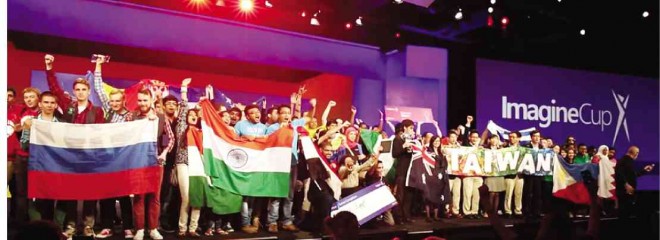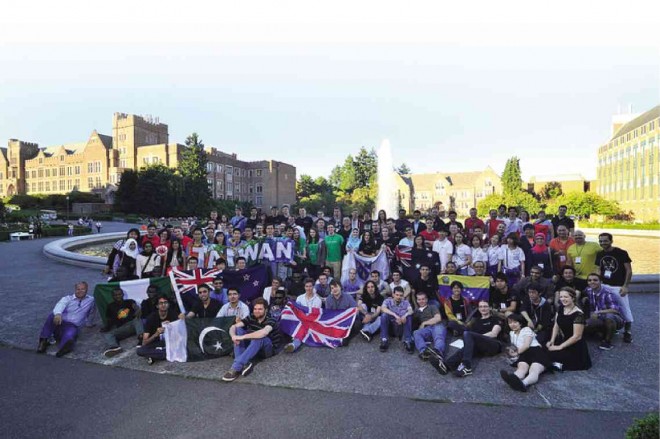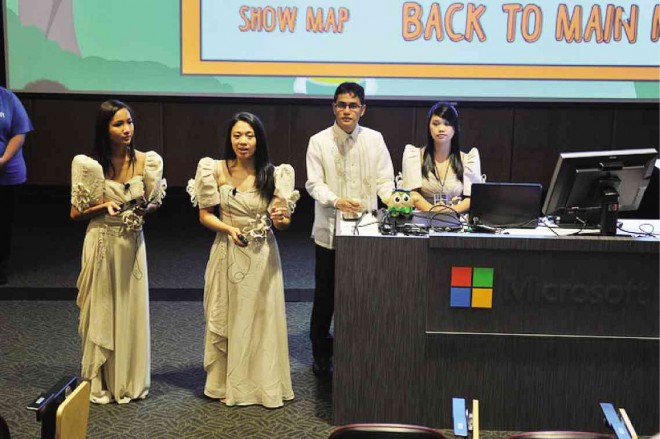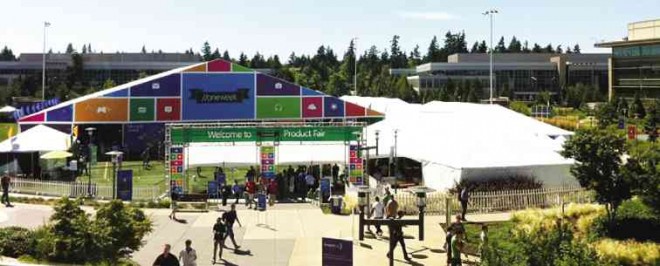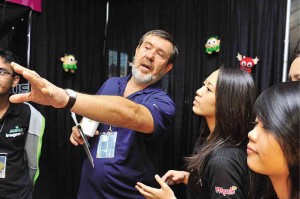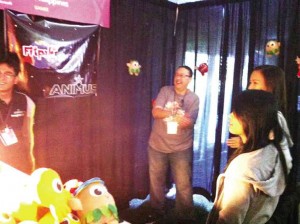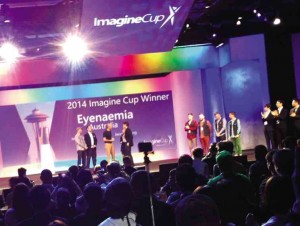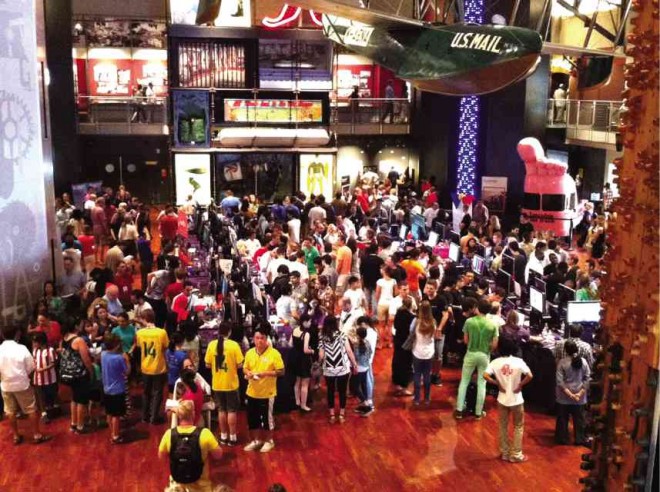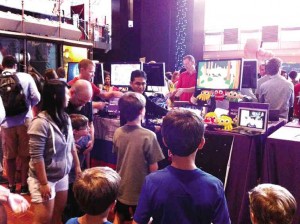Imagine there’s heaven for young techies
Microsoft has been spending a lot of time and money to break the old code that youth is wasted on the young.
Every year, for 12 years now, the world’s largest developer and provider of computer software, services and hardware holds a competition among college students called the Imagine Cup.
Students who have an interest in coding are encouraged to form teams, develop an original technology project and design a business plan that will enable them to market their creation. The primary requirement is that the students use Windows, Microsoft’s operating system; Windows Phone, Microsoft’s smartphone operating system, or Windows Azure, Microsoft’s cloud platform.
Over the years, the Imagine Cup has become the world’s leading arena for student techies, developers and aspiring entrepreneurs. It has inspired more than 1.7 million students worldwide to dream big, innovate and learn important life skills through competition.
According to Steve Guggenheimer, Microsoft’s corporate vice president and chief evangelist, close to 33,000 students participated in teams this year at the national level in more than 100 countries.
Article continues after this advertisementThe national winners in each of the three categories—Games, Innovation and World Citizenship—went on to the regionals where, in turn, judges selected the teams that would qualify for the Imagine Cup World Finals (ICWF).
Article continues after this advertisementThis year, the Asia-Pacific region was represented by the Philippine team Animus, composed of four De La Salle-College of St. Benilde students, in the Games category, by the New Zealand team Estimeet in the Innovation category and by the Australian team Eyenaemia in the World Citizenship category.
Team Animus used Windows, Kinect for Windows SDK (software development kit), Visual Studio (Microsoft developer tool) and Facebook API (platform for social networking apps) to come up with their project Fit Pals. The New Zealand students used Windows, Windows Phone, Microsoft Azure, Bing/Bing Maps, Visual Studio and Facebook API for their project Estimeet. The Australian team used Windows Server, .NET Framework (software framework) and Visual Studio for their project Eyenaemia.
Needless to say, only the brightest young techies in the world made it to the 2014 ICWF, which was held, for the first time in the competition’s history, in the Pacific Northwest— specifically Seattle and Redmond, Washington, in the United States, where Microsoft’s global headquarters is located.
“We’re down to the Top 34 teams from 34 countries,” said Guggenheimer. “It’s a pretty big honor. We love what the students are doing.”
In 2004, Microsoft added a new phase to the Imagine Cup program. The first-place teams from each of the three categories would have to compete live onstage in a championship round before the overall winner of the Imagine Cup could be declared.
This year, the final round VIP judges were Microsoft chief executive officer Satya Nadella, Code.org founder Hadi Partovi and Reddit general manager Erik Martin. These names mean nothing to the technologically challenged but among the students at ICWF, they were pretty big-time and electrifying.
Just before the grand winner was announced, a prerecorded video message from Microsoft founder and technological adviser Bill Gates was shown to the delight of his young fans.
“Congratulations to all of you for the work you have done so far in the Imagine Cup,” he said. “The great thing about young innovators is that they see things that the rest of us don’t. They have a fresh perspective and a new way of looking at old problems.”
The Imagine Cup students, he said, reminded him of Microsoft’s early days when he “pulled all-nighters and worked 18-hour days” with Paul Allen, his friend and cofounder.
“One of the amazing things about software development is that one or two people with a great idea, sitting in a dorm room or a garage, can make a huge impact,” said Gates. “With today’s technologies, like cloud computing and easy downloads for mobile devices, the opportunity to have a big impact very quickly is larger than ever. The Imagine Cup is an excellent way of recognizing the world’s young innovators and encouraging them to keep working on their ideas that can change the world.”
Microsoft has plans of extending the Imagine Cup program to high school students who have the desire to create and code using Microsoft technology.
More than a competition, the Imagine Cup is a celebration of youth creativity and collaboration. It is also, quite obviously, an investment in the future.
By identifying the talented techies early in the game, Microsoft is able to offer them the opportunities, resources and experience they will need not just to land incredible careers but also to translate their bold ideas into products and services that can better the world.
(Next week: How Team Animus made it to the Imagine Cup world finals)
Day 1
Students flew into the state of Washington for the Imagine Cup World Finals in late July. They came from 34 countries around the world, armed with their apps, their gadgets, their business plans and their sense of adventure.
They checked into dormitories at the University of Washington (UW), venue for many of the Imagine events, including a briefing to prepare the competitors for the week ahead and a welcome reception at the university’s Red Square, hosted by AT&T Developer Program.
Day 2
The competitions began bright and early with live presentations at UW. Each team had its turn to present its project for 10 minutes max before a panel of judges. Another 10 minutes were given to each team to answer questions from the judges. After lunch, all the teams hied off to the Microsoft global headquarters in Redmond to set up their projects for the next day.
Day 3
All the teams were shuttled to the Microsoft campus for the hands-on judging. Each judge spent 15 minutes with each team, trying out their app directly, asking questions and giving advice. At the end of the judging, the showcase was opened to the Microsoft staff.
The Imagine Cup was just one activity during what was called One Week, a Microsoft homecoming of sorts that also featured a products fair and a “hackathon.” Members of the media were given a tour of the Envisioning Center, where scenarios were, well, envisioned. Absolutely no photos.
In the evening, the Partner Awards were handed out during dinner at Seattle’s most famous landmark, the Space Needle.
Day 4
Bright and early, the competitors all headed for the Imagine Cup World Championships, which became the highlight of the Microsoft TechReady conference at Washington State Convention Center. The students were given a rock-star welcome by the audience, composed of Microsoft partners and employees, and international media.
The much-awaited winners were named in the Games, Innovation and World Citizenship categories. And then the three first-place teams competed live onstage to see who would take home the Imagine Cup and get a private meeting with Microsoft founder Bill Gates.
The ceremony was the culmination of a weeklong event that celebrated the power of student innovation.
In addition to the cash prizes, each of the first-place winners in the three categories was promised a “boot camp” experience from Microsoft Ventures, Microsoft YouthSpark or PAX. This may be the best part about winning in the Imagine Cup because the young techies will receive hands-on mentorship and project development support from industry experts.
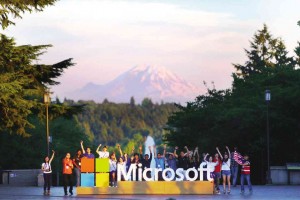
Team Eyenaemia from Australia won the highest honors for its app that uses a selfie to detect anemia.
In the afternoon, the student teams participated in the Amazing Seattle Race. Equipped with GPS devices, students went on a scavenger hunt across downtown Seattle, culminating at the Space Needle.
That evening, a big celebration awaited the students at the Experience Music Project and Science Fiction Museum.
Here are the Imagine Cup 2014 winners:
Games category
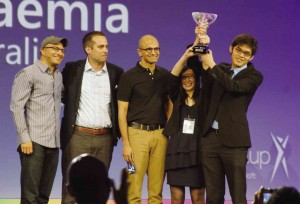
Second place, $10,000 prize: Team Bomon from Korea for project Under Bed
Third place, $5,000 prize: Team Illogic from Egypt for project Puppy in Bubble
Innovation category
First place, $50,000 prize and Microsoft Ventures boot camp: Team Estimeet from New Zealand for project Estimeet
Second place, $10,000 prize: Team Tep from Hungary for project Tep
Third place, $5,000 prize: Team Butterfly from Bahrain for project Nail Polish Mixer
World Citizenship category
First place, $50,000 prize and Microsoft YouthSpark boot camp: Team Eyenaemia from Australia for project Eyenaemia
Second place, $10,000 prize: Team SMART crew from Taiwan for project Versatility of Usens: From Lab to Life
Third place, $5,000 prize: Team Access Earth from Ireland for project Access Earth
Other awards
Apps for Office Challenge awarded by Microsoft Corp. vice president and host of the Imagine Cup Steve Guggenheimer: Team iGeek from China
Facebook Creativity ($25,000 in ad credit) awarded by developer Christine Abernathy: Team ij Developers from Cyprus
Windows Prize awarded by Microsoft Corp. vice president Horacio Gutierrez: Pomato Apps from Venezuela
AppCampus (20,000 euros) awarded by Guggenheimer: Team Brainy Studio from Russia
Day 5
One last showcase: Imagine Cup Day at the Museum of History and Industry. At this free public event, Seattle families were given the chance to try out the students’ projects and vote for their choice of the best app. Entertainment was provided by break dancers and a live band. Children enjoyed the mad science projects as well as the free treats.
After the museum showcase, the students attended Seattle’s Seafair celebration with fireworks, live music and an evening air show over Lake Washington.
